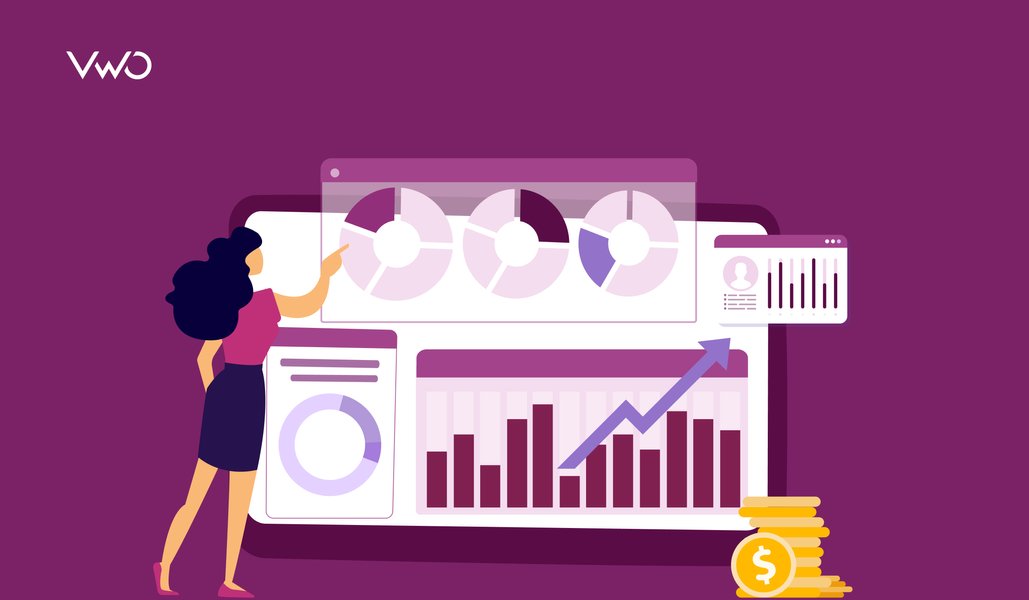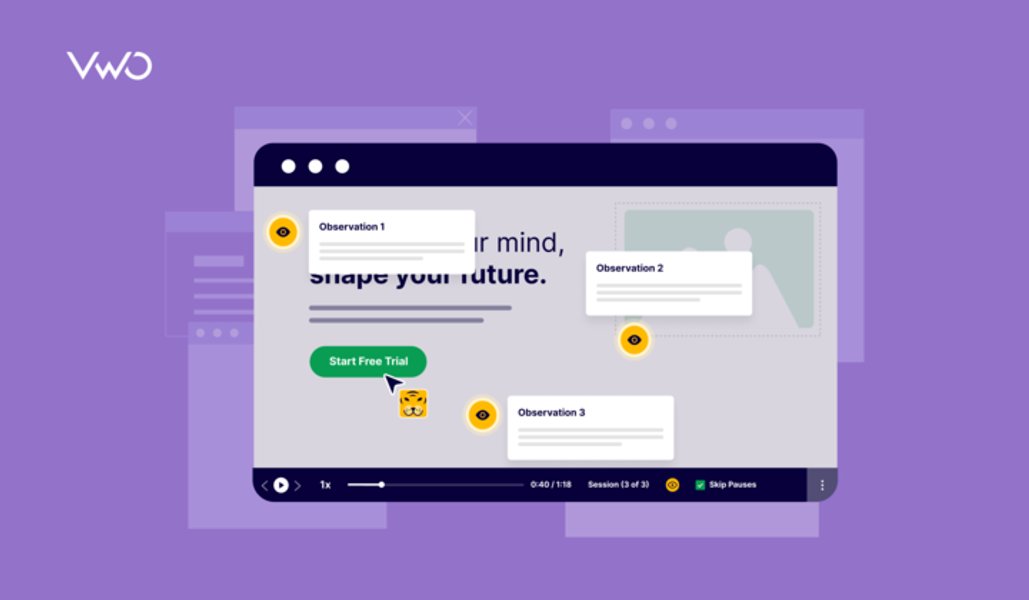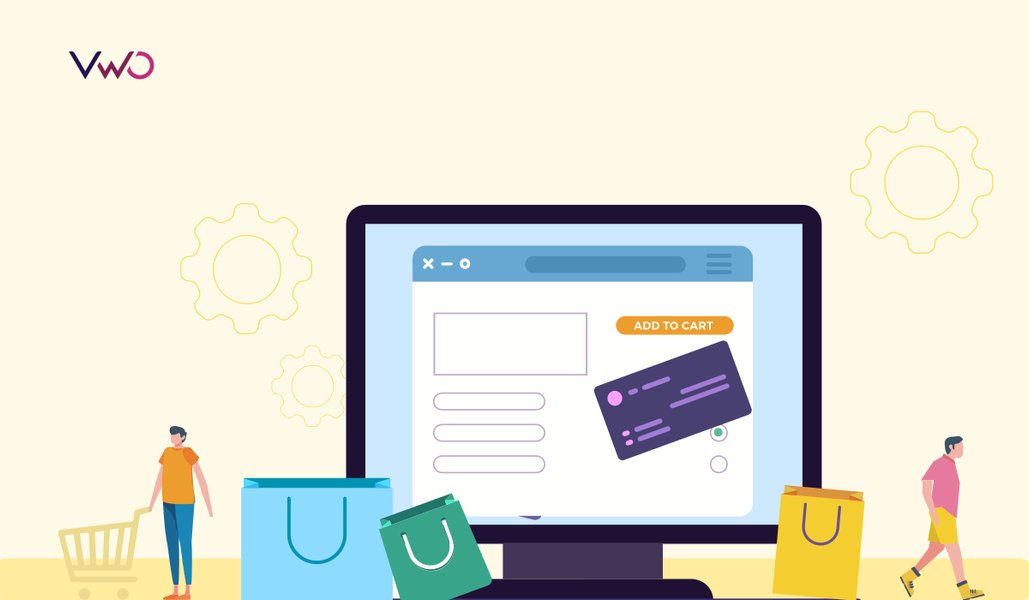Your website is not a shop on a street corner where passersby can peek in and decide to stop by.
Discovering an online store is far more challenging than finding one offline. There is no foot traffic or chance encounters. Instead, your website is one of countless others in a vast, crowded online space.
You need to actively drive traffic and stand out from the rest to showcase what you offer.
Without a steady flow of visitors, increasing conversions and boosting your business’s bottom line becomes a steep hill to climb.
So, where should you start? By reading this blog, you will take the first step toward understanding industry benchmarks and current trends. Our compilation of website traffic stats will help you compare yourself against peers and tailor your strategies to attract the right traffic to your site.
Further, we’ll discuss why merely driving traffic isn’t enough and what you should focus on afterward.
Continue reading to find out more.
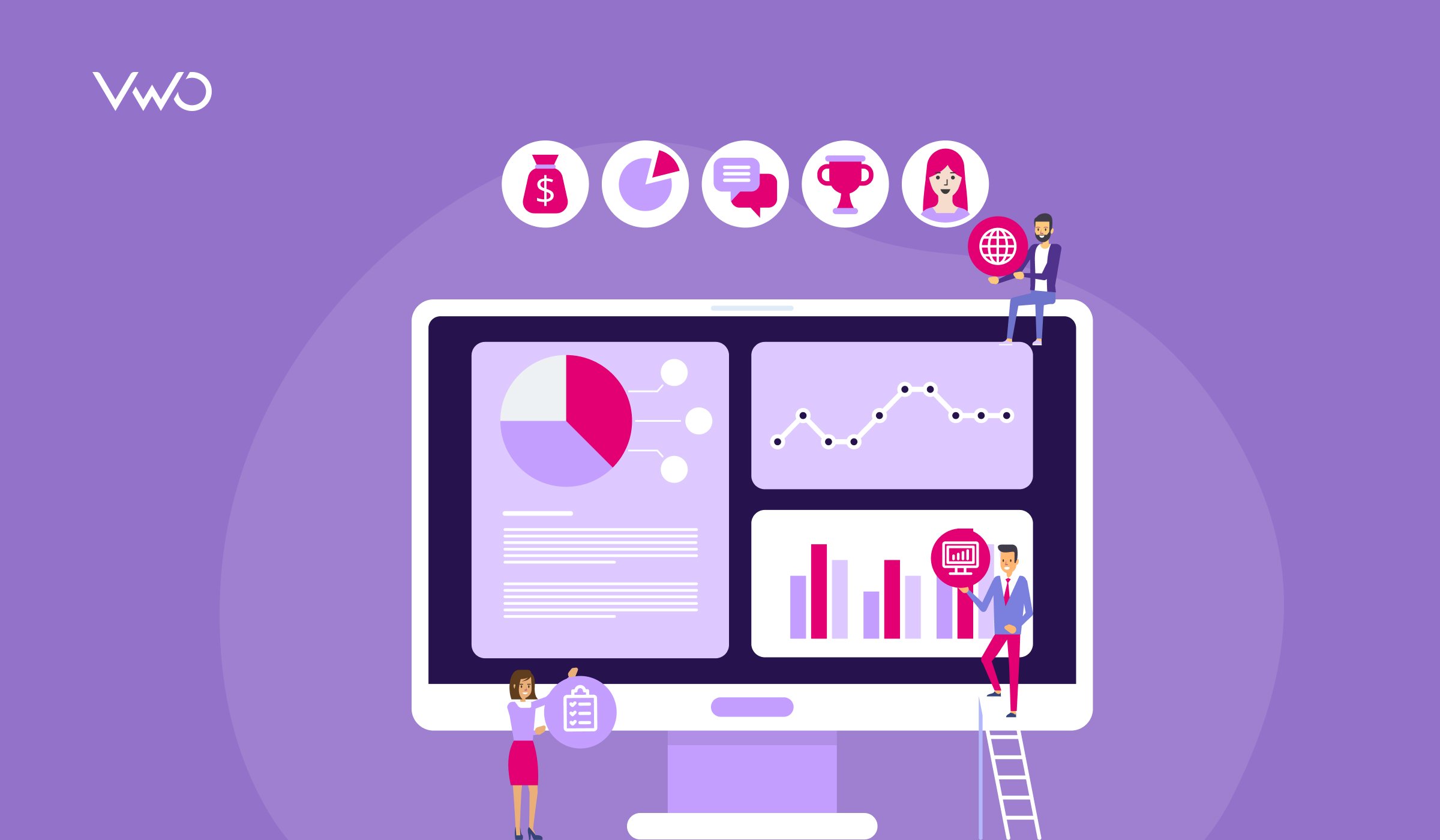
Important statistics by website size
(Source: HubSpot)
1. Around 8% of businesses with under 10 employees have 250,001-10M total monthly visitors.
Achieving such high volumes of traffic shows that even the smallest businesses can pull in big volumes of visitors. Small businesses should continue their efforts with a focus on local SEO, a robust content marketing strategy, and, if possible, targeted ad campaigns to drive traffic effectively.
Lastly, but more importantly, they should invest in improving their website user experience to retain visitors and increase traffic over time.
2. Sites with 1000+ employees made up the largest portion that gets between 50,001-250k and 250,001-10M total monthly visitors.
Since large organizations boast substantial resources, they enjoy greater freedom in experimenting with diverse strategies aimed at increasing website traffic. These companies must already benefit from advanced SEO, innovative content formats, targeted emails, and diverse paid advertising methods. They may explore influencer and industry expert collaborations to further extend their reach and build trust.
3. Approximately 31% of firms with 201-500 employees receive between 50,001-250K and 250,001-10M total monthly visitors.
Investing in SEO to drive organic search traffic and content marketing to reach out to an interested audience can be beneficial. Running well-targeted ad campaigns and increasing marketing spend can also improve the flow of monthly visitors to their websites. Further, companies belonging to this category must optimize and personalize user experiences to encourage more visitors to come back and engage with their websites.

Image source: LinkedIn
4. In 2023, more than four in ten business-to-business (B2B) sites (41.2%) generated between 1,000 and 10,000 monthly visitors.
(Source: Wix)
Businesses need well-informed content before investing in your products or services. Hence, to drive traffic and leads for B2B, focus on developing and promoting high-quality content. Networking at trade events and webinars helps, but a more efficient approach for B2B companies is using LinkedIn and other professional networks to promote your website and attract relevant traffic. Optimizing your B2B website for conversions is crucial to boost visitor numbers and encourage potential customers to fill out forms and request demos.
5. Around 39.1% of business-to-customer (B2C) sites receive between 1,000 and 10,000 monthly visitors.
(Source: Wix)
B2C businesses can drive traffic through landing pages and even specific product pages by showing results for users’ queries on search engines. They can also use social media to promote products and appeal to a larger audience base. By offering incentives such as loyalty programs and special offers, the possibility of repeat visits increases. Last but not least, the user experience should be optimized for the site, with an emphasis on mobile responsiveness.
6. 21% of small businesses cite low traffic as their biggest website challenge.
(Source: Forbes)
Small businesses often face the unique challenge of limited resources, making it difficult to compete with larger companies in driving website traffic. They must prioritize cost-effective methods like SEO and content marketing. Investing in paid advertising should be considered only if budget permits, as it requires a consistent allocation of money. They should leverage email marketing, for it doesn’t require substantial investments, making it a cost-effective tool for driving traffic.
Crucial statistics by user age
7. The 18 to 24 age group is the largest segment of people using the internet across the world.
(Source: Statista)
This age group mostly accesses the internet through mobile phones. They are accustomed to fast content consumption. Making your website mobile-friendly will help you reach this category if you want to. Further, creating interesting, eye-catching content helps them land on your site. Talking about relevant topics on youth-friendly platforms like Instagram or TikTok will also allow you to target a younger audience.
8. The global digital population aged 65 or older represents approximately 4.2% of all internet users.
(Source: Statista)
Older adults typically have issues navigating complicated websites and small font sizes. Designing websites with large fonts, a very simple layout, and high-contrast colors will enhance readability and usability for this demographic. Easy-to-follow tutorials will help them confidently use a site by overcoming barriers that might be stopping them from having the best online experience.
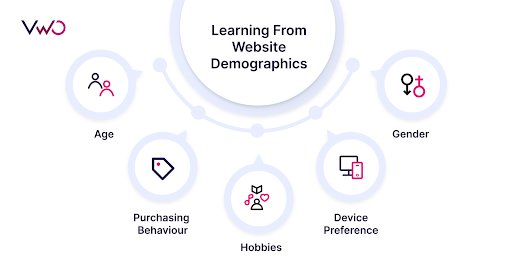
9. 55% of online boomers are more likely to use a website offering information or support dealing with a specific medical condition or personal situation.
(Source: Pew Research Centre)
Most boomers are looking for reliable information and support regarding health or their personal situations. Giving them comprehensive, validated health resources and providing support forums will meet their requirement for reliable and detailed information. This will help them build trust in your website and even promote word-of-mouth to bring more new visitors to your website.
10. 62% of Boomers are more likely to use government websites.
(Source: Pew Research Centre)
In addition to the typical tactics (SEO and PPC), you can attend or sponsor the kinds of events that tend to attract Boomers. This will help you convert these interactions into increased traffic to your site.
Partner with or produce content for organizations or influencers whose audiences include Boomers. Prioritize popular social media channels like Facebook where this demographic is mostly active. Share your best content, bid on their ads, and join groups or communities to engage them in relevant conversations.
11. 83 % of users aged 35 to 54 visit Amazon for shopping ideas and inspiration.
(Sources: Statista)
Impulsive buying is the characteristic of B2C customers who now look forward to ideas and advice while making a purchase. You can introduce features like personalized recommendations, buying guides, and product reviews to introduce an Amazon-like experience in shopping on your website. This will enable shoppers to find their products quickly and more efficiently.
Key website traffic statistics by source
12. Direct traffic accounts for 22% of total website visits.
Direct traffic means that users are typing in URLs or using bookmarks to get to your site. It’s usually your most valuable traffic because these users already either know who you are or have a strong motivation to visit your website. The higher the direct traffic, the better, since it indicates strong brand recognition.
13. Organic search contributes 17% to overall website traffic.
Organic search traffic refers to traffic from search engines and is a good gauge of SEO performance. It depends on how well your content matches what people are searching for. Keyword research, quality content creation, and technical SEO improvements (eg, site speed and mobile responsiveness) are some areas that should be taken seriously to maintain a steady flow of organic traffic.
14. Social media drives 16% of website traffic.
Social media traffic indicates user engagement across platforms, but we suggest that you focus on where your audience is most active to streamline your efforts. Create platform-specific content and strategies to boost traffic by sharing engaging posts, running targeted ads, and interacting with your audience.
15. Email marketing brings in 14% of website visitors.
Traffic from email marketing reflects how your email campaigns are performing in terms of getting users to your site. In other words, how good are your email lists, how relevant is your email content? This is another channel where you get directly measurable results and very good ROI, because of the targeted and personalized nature of emails.
16. Display ads generate 12% of website traffic.
Display ads, which encompass banner ads and visual promotions across various websites, play a vital role in driving traffic. But display ads are costly and may have lower conversion rates compared to other channels. Further, ad blockers can reduce their visibility, potentially limiting their effectiveness.
17. Paid search accounts for 9% of the total website traffic.
Paid search traffic, generated through ads on search engines like Google, is the best metric to know if your PPC campaigns are working. It provides quick traffic by showing your ads at the top of search results based on user queries and the intent behind the selected keywords. The downside is that it can be very costly, especially if you are in a very competitive line of business. It also requires ongoing optimization and management over time to sustain effectiveness and ensure a favorable return on investment.
Watch this webinar to learn how to ensure a cohesive PPC campaign for maximizing conversion rates from the paid channel.
18. Google is the largest traffic-referring domain for all sites on the web, accounting for 63.41% of referrals.
Google’s monopoly on traffic is proof that SEO and search engine visibility are indeed vital. But when it comes to driving traffic to your website, you really do want to have your eggs spread out in multiple baskets. By diversifying your traffic, you’re reducing your dependence on Google. That way, if the search giant changes its algorithm, you’ll be able to withstand the impact. You’ll also be able to reach a larger, more diverse audience.
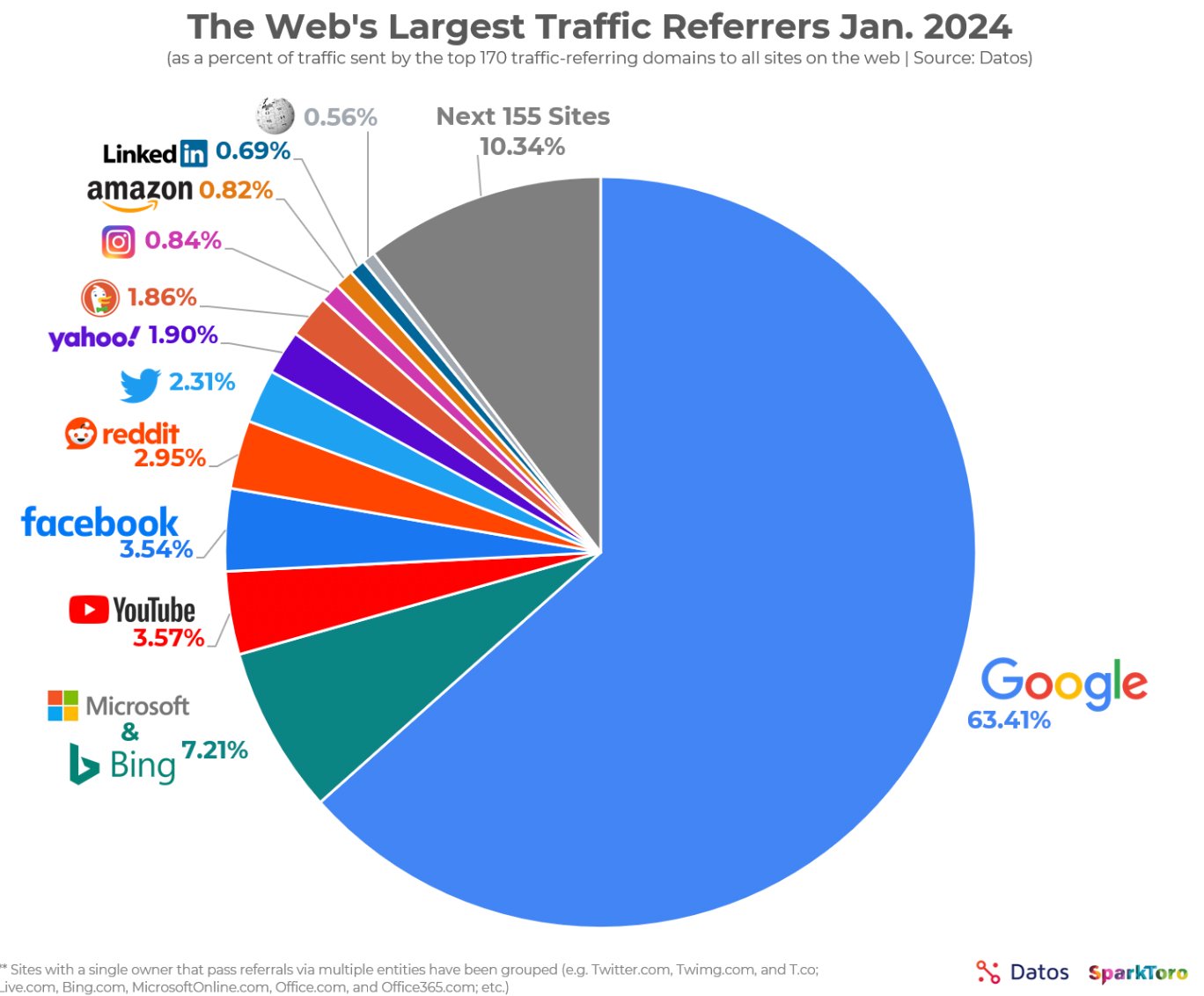
19. Microsoft and Bing together are the second-largest traffic-referring domains, contributing 7.21% of referrals.
You can decide to invest efforts in Bing because competition is less intense, making it easier and more cost-effective to rank higher. However, this should only be a priority if Bing’s audience—typically older, affluent, and well-educated—matches your target audience. If it doesn’t, treat Bing as a secondary focus—valuable for diversifying traffic but not your main effort.
20. YouTube is the third-largest traffic-referring domain, driving 3.57% of web traffic.
As the most popular video platform, YouTube is a great way to reach and be seen by a large number of people, especially millennials who are more likely to watch a video than read an article. It allows you to raise awareness of your brand and provides a wealth of highly shareable, interesting content. It also lets you leverage the power of the Google ecosystem, since videos often show up at the top of Google searches, which will strengthen your SEO.
To dive deeper into several proven strategies for growing traffic, check out our in-depth guide.
Download Free: Grow Website Traffic Guide
Traffic stats by user devices
(Source: HubSpot)
21. Mobile devices bring 41% of website traffic.
To make the most of significant traffic coming from mobile devices, focus on enhancing mobile SEO. This includes improving page load speed and optimizing your site for local search queries, which can help your website rank better in mobile search results and attract more users.
22. Desktop devices account for 38% of web traffic.
Desktops can handle richer media experiences, so showcasing high-quality visuals can make your content more compelling and engaging. Further, you can show interactive features like filters, comparisons, or detailed content sections. These features leverage the larger screen and processing power of desktops, improving user engagement and providing a more dynamic experience.
23. Tablets contribute 19% of website traffic.
On tablets, optimizing for touch gestures is crucial. Ensure that interactions like swiping and zooming in/out are intuitive and responsive to enhance the user experience. Additionally, design tablet-specific content layouts that take advantage of the tablet’s screen size. For example, split-screen views or larger touch targets can make the content more accessible and visually appealing on tablets.
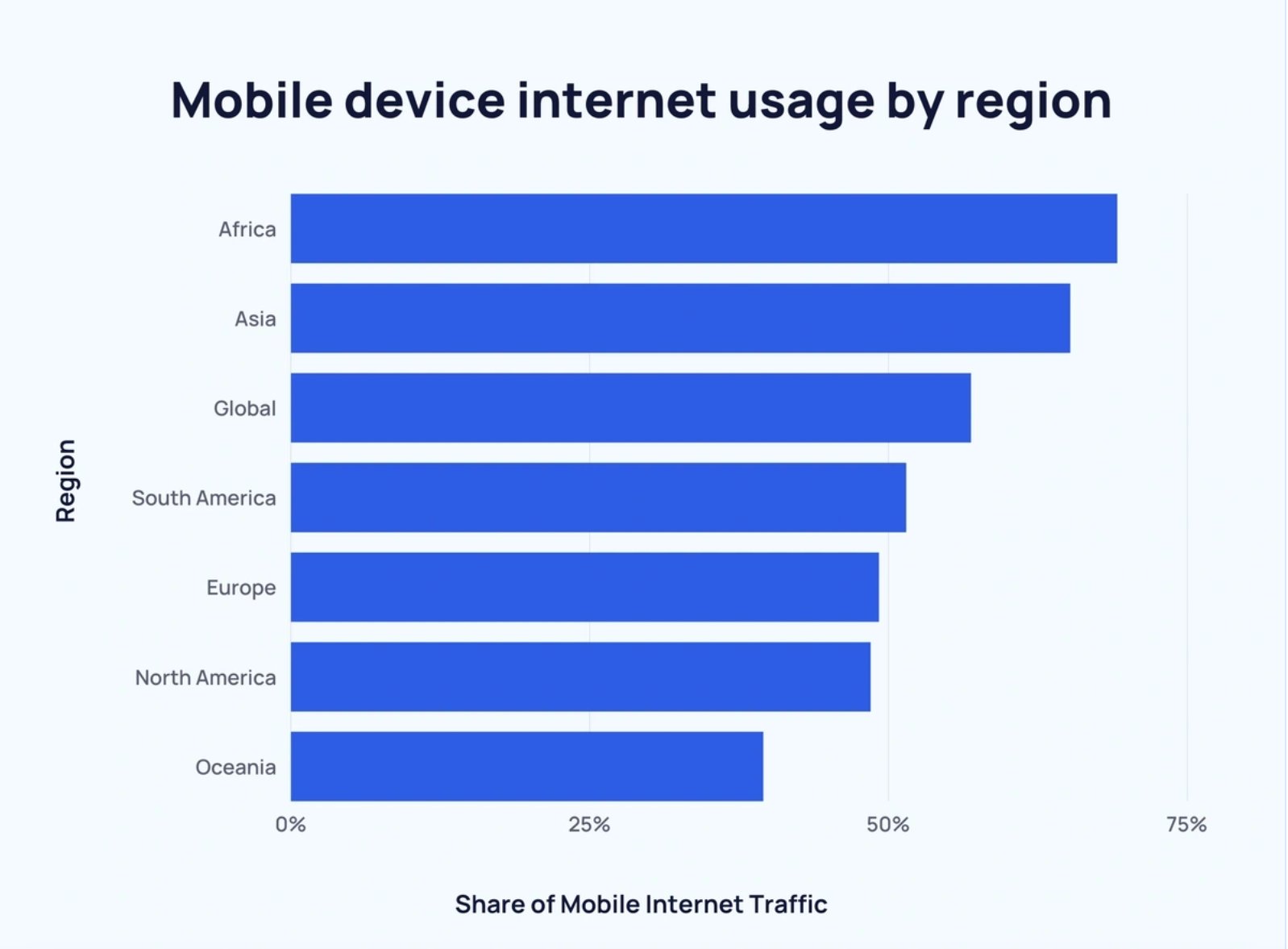
Important website traffic markers across business niches
(Source: Databox)
24. The apparel & footwear industry has an average of 30.49K new users.
To acquire more new users, using personalized marketing strategies such as sending targeted emails with special offers will help. You may also host fashion influencers that will promote your products to their followers, and use social media ads to target more audiences.
25. The automotive industry has 4.15K new users on average.
SEM and targeted ads are some of the avenues that could be used for automotive websites to attract more visitors to these sites. Some other interactive features, including car configuration and virtual test drives, will engage the site visitors with the website and multiply the possibilities of conversion into sign-ups or information requests. Moreover, collaboration with bloggers and influencers focusing on the automotive sector will enhance visibility by attracting new users and lead to overall growth.
26. The construction industry sees around 1.7K new users.
Detailed case studies, client testimonials, and industry insights can be published to attract and engage potential users. Companies can take part in relevant forums and webinars focusing on niche topics. Needless to say, SEO and targeted advertising can always be leveraged to increase site traffic and drive conversions.
27. Consulting & professional services average 2.11K new users.
For this category, companies should publish white papers, research reports, and other articles demonstrating thought leadership in the field. Marketing these papers by targeted advertising on LinkedIn, and joining relevant industry groups, can help reach the right audience and attract new users. Offering free resources such as webinars or consultations can position these firms as industry leaders, thereby getting noticed by the right kind of audience.
28. eCommerce & marketplaces have 6.56K new users on average.
Using personalized marketing by recommending features or offering special deals can increase customer acquisition. Promotional campaigns can be run to attract more people to the site, and social media can be used to showcase products and special offers. SEO can be leveraged to appear higher in search results and to increase sign-ups. Most importantly, with several pages on eCommerce websites, optimizing the website experience is a must for moving them down the funnel. This ensures they remember the positive experience and are more likely to return.
29. The education industry records about 10.95K new users.
Offering free courses, free webinars, free downloadable study materials, answering questions on Quora, and even just posting regularly on social media can help attract students. SEO strategies to capture education-related search terms, social media advertising to drive new user acquisition and involvement with education-oriented influencers – all are ways of getting the word out there.
30. The food industry averages 11.2K new users.
Compile some interesting content such as recipes, cooking tips, food trends, etc that encourages visitors to keep coming back for more helpful content. Collaborations with influencers and experts can be used to get more users to the site. Sites can also be optimized for SEO and be used to run targeted advertisements and get more users to the site.
31. The healthcare industry has an average of 2.85K new users.
Useful health content, such as expert articles, patient stories, health tips, and informative guides can attract new audiences. You can combine this with SEO optimization and active participation in online health communities to expand your reach. Partnering with health tech influencers or diving into some community-centered outreach programs can help build trust and expand an audience.
32. B2B site traffic from organic search fell from 39% to 27% between 2019 and 2024.
(Source: Webbiquity)
B2B organizations may have to target their marketing effort with account-based marketing or forge strategic partnerships. Paid advertising and intensified presence in industry-specific forums and communities will also help increase the number of visitors.
33. B2C sites receive 40,001–100K unique visitors a month 22.5% of the time, while only 16.7% of the B2B sites reach such volumes.
(Source: HubSpot)
B2C companies can further optimize their content for search engines by focusing on high-value keywords and producing in-depth industry insights that cater to their target audience. Additionally, enhancing the user experience on their websites, such as improving site speed and mobile responsiveness, can help retain visitors and convert them into leads.
Some more website markers for you to know.
Average session duration
Average session duration is not directly related to traffic generation but it’s still an important metric. The longer the average session duration, the more engaged your visitors are once they find you, which in turn can lead to increased conversions. I encourage you to skim through the average session duration to better understand how your own website traffic compares to others in terms of engagement.
(Source: Databox)
34. The apparel & footwear industry has an average of 18.16K sessions.
35. The automotive industry averages 11.2K sessions.
36. The eCommerce & marketplaces sector averages 9.57K sessions.
37. The education industry typically sees around 6.54K sessions.
38. The food industry has an average of 10.43K sessions.
39. The healthcare industry records an average of 4.21K sessions.
40. The SaaS industry averages 3.16K sessions.
Bounce rates
If visitors are not spending time on your website, what are they doing? They’re bouncing! While you can’t avoid this entirely, it’s disappointing when visitors leave prematurely without taking any action. Here are some bounce rates across industries. See how your website compares to the industry standard.
(Source: CXL)
41. Food & drink industry experiences an average bounce rate of 65.52%.
42. News sites encounter an average bounce rate of 56.52%.
43. Beauty & fitness sites display an average bounce rate of 55.73%.
44. Autos & vehicle websites present an average bounce rate of 51.96%.
45. Finance sites report an average bounce rate of 51.71%.
46. Travel websites experience an average bounce rate of 50.65%.
47. Business & industrial sites show an average bounce rate of 50.59%.
48. Jobs & education platforms have an average bounce rate of 49.34%.
49. Games sites demonstrate an average bounce rate of 46.70%.
50. Shopping websites display an average bounce rate of 45.68%.
Turn traffic into leads with website optimization
You might ask how website optimization ties into traffic growth. We touched on improving user experience and optimization in various places in the blog. Now, let’s break it down for you.
High traffic is useless if visitors don’t convert. The real challenge is turning that traffic into leads or customers. To achieve this, optimize your site to enhance user experience and reduce friction, ensuring visitors take action. VWO supports you throughout, from user research to testing, to help convert traffic into tangible results and improve your ROI.
User research
Traffic shouldn’t be seen just as a metric. It reflects real audiences landing on and engaging with your website. To understand the nuances of their behavior, you need to move beyond simple traffic reports. If traffic analytics indicate a lag, go straight to user behavior tools to identify what might be causing users to drop off.
VWO Insights – Web provides heatmaps, session recordings, surveys, and form analytics to give you a comprehensive view of visitor behavior. This helps identify friction points and areas of high engagement, allowing you to focus on effective changes rather than unnecessary ones.
A real-life case study: RunScape, a multiplayer online role-playing game, saw traffic coming from various sources, with direct traffic dominating the mix. To provide a consistently great experience for their visitors, they closely monitored behavior on their most important pages. By studying heatmaps and watching recordings for the ‘Treasure Hunt’ page, they discovered that visitors were seeking clearer information, and its absence was creating friction in their journey. By adding more relevant information based on these insights, RunScape achieved a 10% increase in purchases.

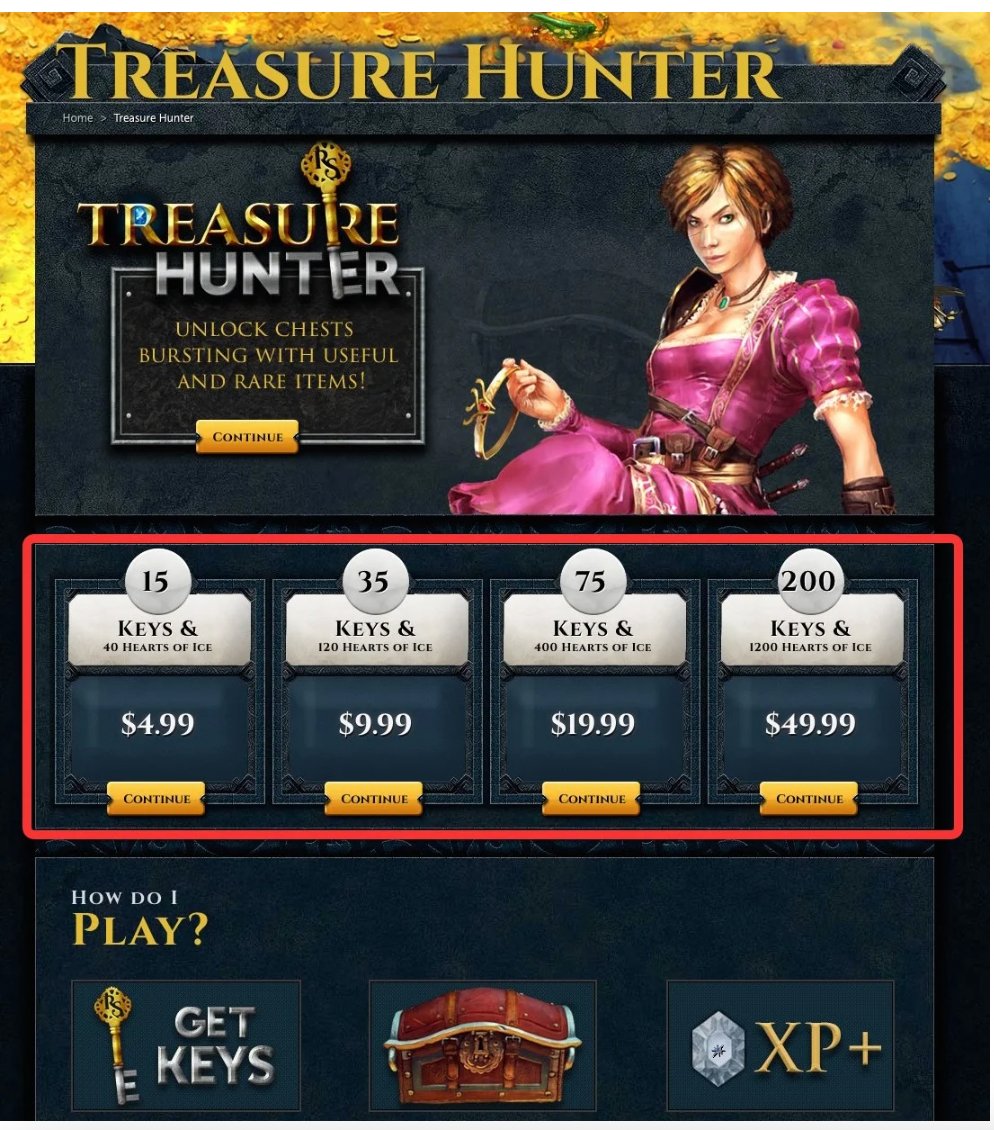
Testing
Once you create an improvement plan based on these insights, don’t rush to apply it. Test the changes against the live version of your website elements to verify if they address the issues effectively. If the changes you make are successful, you’ll see better results in metrics like conversion rates, purchases, revenue, form submissions, and sign-ups. The version that improves numbers for your chosen metric and is backed by statistical significance should be applied.
VWO Testing offers a comprehensive range of testing options for your website, from basic to advanced. Whether you’re looking to make simple changes with a no-code editor or conduct functional testing on the server side, our platform ensures you’re fully confident in the experiences you deliver. Additionally, our advanced statistical engine provides smart, accurate, and statistically significant test results, ensuring your decisions are always data-driven.
A case in point: Hyundai Netherlands received mostly paid traffic ( some direct and SEO traffic too) to their landing pages showing car models. They wanted to test what could help this traffic convert better. By leveraging VWO’s advanced testing capabilities, the team ran multivariate tests to correctly identify which changes influenced visitors to take action (download a brochure or book a test drive). Consequently, Hyundai achieved a 62% increase in leads and 200+ click-through rates. Read the full success story to learn exactly what improvements were made on the landing pages.

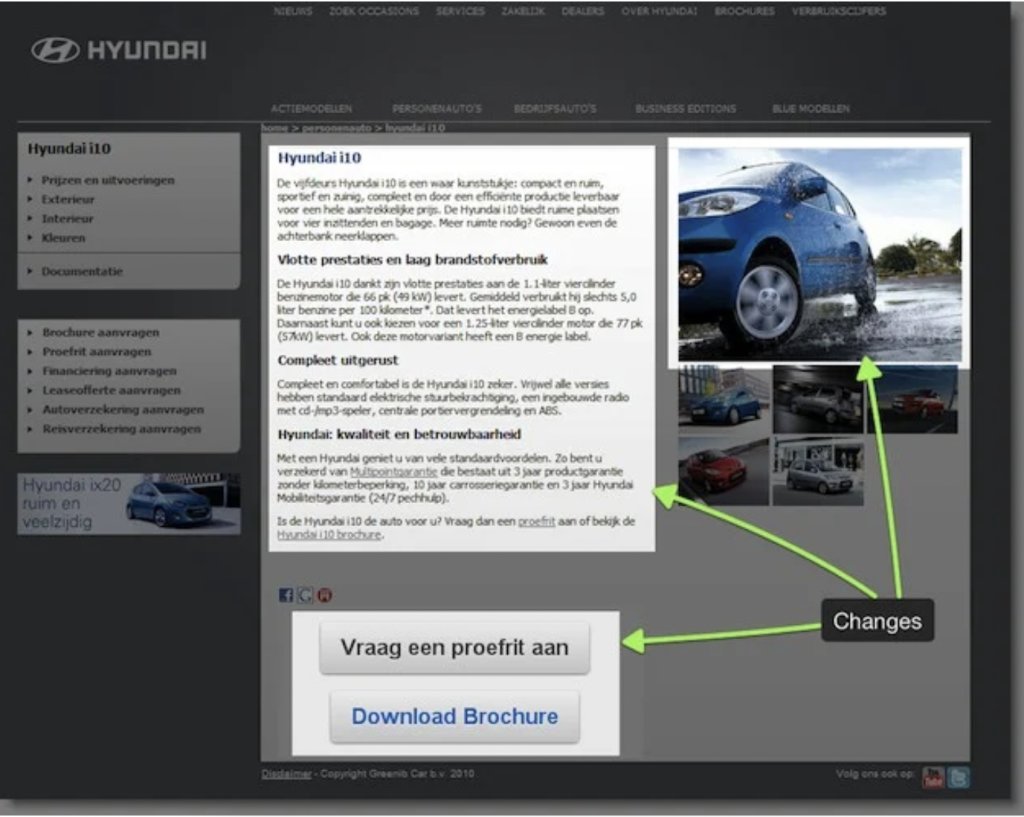
Have enough traffic to your website? Let VWO help you optimize your experience and convert that traffic into valuable leads. Try it for free today!
Conclusion
Our goal was to provide you with a starting point through this blog. Without knowing the current traffic stats, it’s hard to gauge how far you need to go. Some numbers might motivate you to act, while others will highlight where to better focus your efforts. If you leave today with a clear understanding of these points, that is a win for both of us.
Once again, we can’t stress enough how challenging it is to turn that traffic into engaged visitors and buyers. Having worked with numerous clients, we know the struggle they face. Hence, to handle everything from research to experimentation after generating traffic, consider using a platform like VWO. Request a demo, and our team will show you how to make the most of it. The choice is yours now.


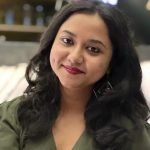

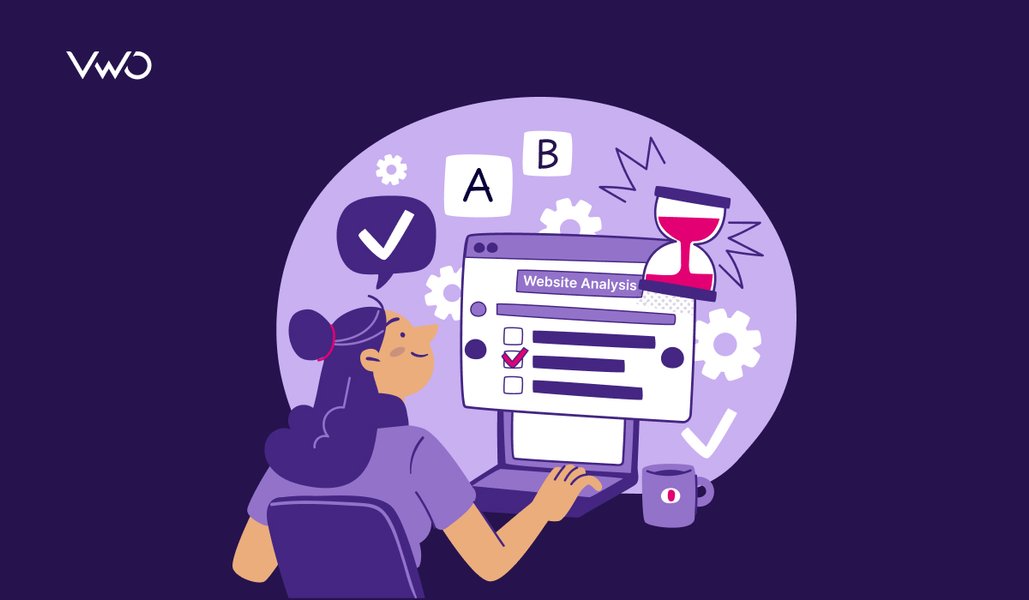
![7 Best Website Monitoring Tools [2026]: Expert Insights to Help You Pick the Right One](https://static.wingify.com/gcp/uploads/sites/3/2025/02/Feature-image-7-Best-Website-Monitoring-Tools-How-to-Pick-the-Right-One.jpg?tr=h-600)
